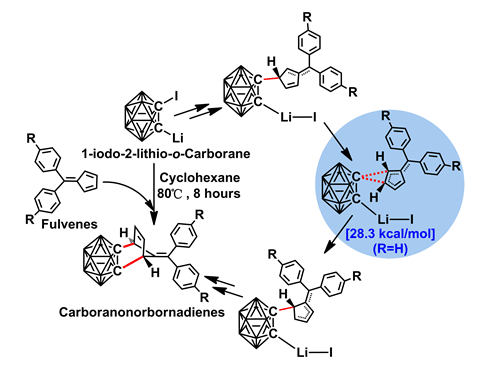摘要/Abstract

运用密度泛函理论的B3LYP方法对1-碘-2-锂-邻碳硼烷与亚甲基环戊二烯衍生物的类Diels-Alder反应进行了理论研究.计算结果显示:1-碘-2-锂-邻碳硼烷与亚甲基环戊二烯衍生物的类Diels-Alder反应为分步过程,需要依次经过脱LiI形成碳硼炔、碳硼炔与亚甲基环戊二烯成键、碳硼烷基1,2-σ迁移和成环四个过程才能形成与Diels-Alder反应形式相同的产物.其中碳硼烷基的1,2-σ迁移过程为整个反应的决速步,在353 K的实验条件下需要越过28.3 kcal•mol-1的自由能垒才能形成相应的碳硼烷基降冰片烯衍生物,理论预测的反应速率与实验结果较好吻合.自然键轨道理论(NBO)分析结果显示:该反应与正常电子需求的Diels-Alder反应(NEDDA)具有相似的电子结构特征.文中还对反应底物的取代基效应进行了讨论,并得到了与实验数据基本一致的结果.
关键词: 邻碳硼烷, Diels-Alder反应, 反应机理, 理论研究, 密度泛函理论(DFT)
Density functional theory (DFT) calculations at the B3LYP level, combining with the double-ζ valence polarized (DZVP) all-electron basis set as embeded in Gaussian 09 Program, were carried out to investigate the reaction mechanisms and substituent effect of Diels-Alder-alike reactions between 1-iodo-2-lithio-o-carborane and fulvenes. For maximum analogy with experimental conditions, all calculations were carried out in cyclohexane solution by using the IDSCRF solvent model, and all energies reported here had been adjusted adaptive to experimental temperature (353 K). According to presently obtained results, this reaction needs to go through a four-step process successively before the final carboranonorbornadiene products are formed. These four steps include forming carboryne intermediate by release of LiI fragment, interaction of carboryne with fulvenes, 1,2-σ migration of carboranyl, and the cycloaddition process. Among all four steps mentioned above, the 1,2-σ migration of carboranyl is predicted to be the rate-determining step (RDS), features an activation free energy barrier of 28.3 kcal•mol-1 under experimental temperature of 353 K. A half-life of 8.7 h converted from the RDS activation free energy barrier coincides well with corresponding 56% isolated yield of carboranonorbornadiene after reacted 8 h. The LiI fragment is found to be vital in stabilizing most stationary points and driving the reaction ahead. The reaction mechanisms change little when the 4-H substituents on diphenylfulvenes (denoted reaction a) is replaced by 4-Me groups (denoted reaction b), but the corresponding RDS activation free energy barrier increased by 2.8 kcal•mol-1 (from 28.3 to 31.1 kcal•mol-1), transferring to a decrease in reaction rate of ca. 50 times. The obvious slower reaction rate predicted in reaction b than in reaction a gives out correct trends with an experimental yield reduction of carboranonorbornadienes from 56% to 42%, and verifies the rationality of B3LYP results in these carboranyl-involved Diels-Alder-alike reactions. Natural bond orbital (NBO) analysis about corresponding reactants and stationary points shows similar electronic characteristics of this reaction with normal-electron-demand Diels-Alder (NEDDA) reactions, i.e., the fulvenes act as electron donator when react with carboryne intermediate.
Key words: o-carborane, Diels-Alder reaction, reaction mechanism, theoretical study, density functional theory (DFT)
PDF全文下载地址:
点我下载PDF
